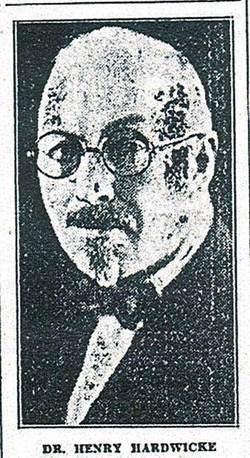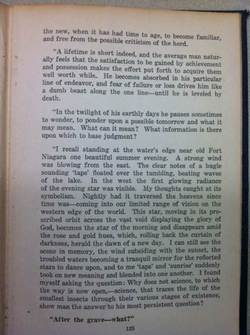by Michelle Ann Kratts
Perhaps some of the most intriguing stories concerning Niagara’s Spiritual past involved an obscure physician and psychologist named Dr. Henry Hardwicke. Born in Niagara Falls to Major Alan H. G. Hardwicke (a native of England and the only thirty-third degree Mason in Niagara Falls at the time of his death and burial at Oakwood Cemetery) and Henrietta Ware (a descendant of a Revolutionary War veteran who also lies buried in Oakwood Cemetery), Dr. Hardwicke’s serious inclinations toward the paranormal may have begun to fully awaken during his service as an Army Medical Officer in the first World War. World War I, with its catastrophic bloodshed, inspired yet another generation to seek communication with their newly deceased loved ones. It is possible that it was during his service in the war that Dr. Hardwicke came into contact with another physician (Dr. Le Roy Crandon) who was said to have had a “morbid obsession with mortality” and a certain charming and enigmatic civilian volunteer ambulance driver, from Ontario, (Mina Stinson Crandon, Dr. Crandon’s notorious wife, also known in Spiritualist circles as Margery the Medium).

Mina Stinson Crandon, also known as “Margery the Medium”
Another source describes the fact that Dr. Hardwicke and Dr. Crandon had a history of practicing together as physicians “in the same neighborhood” (in Niagara Falls?) or possibly there had been some connection through Mina, “well known here…,” (in Niagara Falls) and a cousin of a prominent Niagara Falls resident, the attorney, A. W. Gray. Regardless of how these three individuals were originally connected, they met here in Niagara Falls and they gained worldwide attention for their investigations into the spirit realms and for stumping Harry Houdini. Together, they would shake the very foundation of Spiritualism.

Niagara Falls Gazette, 1925
Dr. Harkwicke’s destiny was to ultimately play a special part in the Spiritual history of Niagara Falls. It would not be the first time his family made local history. The great great grandson of Jesse Ware, noted as the first American born white settler of Niagara Falls, Dr. Hardwicke’s family was quite respected in these parts. Just a young man, Henry Hardwicke may have been present that day in September of 1903 when his mother provided the carriages to convey guests to Oakwood Cemetery where the Daughters of the American Revolution placed a tombstone to commemorate his grandfather’s service in the Revolutionary War. Jesse Ware, a native of New Braintree, Massachusetts, had “shouldered a gun with the Minute Men and went forth to battle at the sound of the alarm from Lexington” and then some years later was summoned to Niagara by a friend (or relative), John Stedman, who had been the master of the very important portage. Following in his grandfather’s footsteps, Dr. Hardwicke found himself a traveler on a new frontier. One that was just as mystical and unknown as Niagara.
As a boy, young Henry was already making the headlines in Niagara Falls. In 1894, he and his friend, Richard Carey, organized a “well-managed affair” on Jefferson Avenue. The bicycle race, which began on Jefferson Avenue in front of St. Peter’s Church followed a course down Jefferson Avenue to Quay Street, down Quay to Erie Avenue, down Erie to First Street and then back to Jefferson Avenue. Boys from all corners of the city “flocked to the spot” and had a thoroughly enjoyable time of it. John O’Donnell was first place winner. Henry presented him with a “handsome silver medal”. His father, A.G.H. Hardwicke, quite possibly had provided the prize which may have come from his hardware store, Hardwicke and Co., located on Falls Street.
As an adult Henry received a medical degree from Hahnemann Medical College in Philadelphia and served in the Army Medical Services during World War I. He practiced as a physician for a time in both Niagara Falls and Erie, Pennsylvania. He was a member of the Niagara Players and portrayed interesting and psychologically complex personalities for productions at the Capitol Theatre. In December of 1917, he was elected Worshipful Master of Niagara Frontier Lodge, No. 132, F. & A. M. Like his father, he had obtained high and mystical ranking as a devoted member of the local chapter of the Free Masons. During the 1920’s he worked as the manager of the Equitable Life Assurance Society of the United States, located in an office building on Falls Street, and frequently gave talks on various insurance related matters.
By the 1930’s, however, Dr. Hardwicke had become a full fledged Spiritualist. He had written at least one book, Voices From Beyond, which was published in 1930 by the Harkell Co., in Niagara Falls, and had travelled extensively on the lecturing circuit.

His subjects included things such as “The Lure of Adventure to the Fourth Dimensional Realms,” use of the camera in psychic research, the direct voice, levitation and cross correspondence. He believed he was sensitive to a disembodied spirit named Walter—a very popular spirit at the time as he was known to show up at Mina Crandon’s séances, too. Walter, the ghostly guide, was supposedly Walter Stinson, a young man who died at Onset Station after being crushed on board the railroad cars near Boston on August 6, 1911. He was also Mina Stinson’s brother.
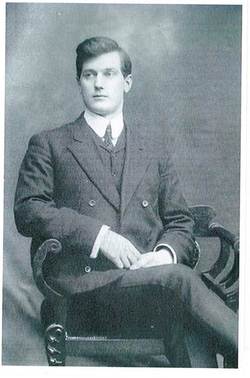
Walter Stinson died shortly after this photograph was taken
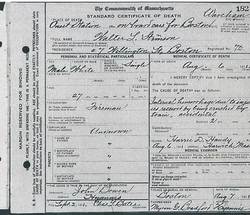
Walter’s horrific death cited on his death certificate, 1911
The spirit of Walter was the driving force behind several very famous experiments which took place concurrently between groups of Spiritualists in both Boston (at 10 Lyme Street—the home of Dr. Le Roy and Mina Crandon) and in Niagara Falls (the home of Dr. Henry and Katherine Hardwicke).
“An experiment in cross-correspondence between Dr. H.S.W. Hardwicke, …Fifty-seventh Street, well known Niagara Falls medium, and Margery, the Boston medium, was reported by Dr. L.R.G. Crandon, husband of Margery, at the meeting of the New York section of the American Society for Psychical Research in Boston. Dr. Crandon reported that séances had been held simultaneously by Dr. Hardwicke in Niagara Falls and Margery in Boston and that an identical thumbprint was made in wax at both places almost simultaneously by Walter, the spirit control of Margery…”
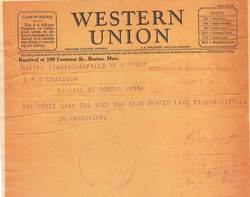
One of the “messages” from the séance at Niagara Falls to the Crandon’s in Boston
Other events involving Walter took place at Dr. Hardwicke’s home, as well. Dr. Crandon had been visiting and as they were sitting in chairs about the room they suddenly heard Walter’s voice….”Hello, Henry! Think I’m dead, do you?” In no time, Dr. Hardwicke fell fast asleep and his wife, Kate, began to talk to Walter about such things as ectoplasm. It was said that Walter took ectoplasm from Dr. Hardwicke’s slumbering body and created a bird, a small sparrow hawk, which was at the top of the piano and then after swooping through the room, finally landed on Kate’s right ankle, where it proceeded to claw through her silk stockings and draw blood.
The stories that came from Dr. Hardwicke’s home bordered on the absurd. A gargantuan Victorian, with turrets that twisted and turned into the sky, the beautiful Fifty-Seventh Street home became the center point of activity in the city of Niagara Falls. Not too far from the banks of the Niagara River and the original landmark of an ancient fortress, Dr. Hardwicke and his wife made their abode into an assembly hall for those who sought an entrance into another world. Séance circles were held regularly and experiments were constantly in the works to prove that there is no death. It is possible that Dr. Hardwicke stopped practicing as a physician quite early on in order to have more time for the paranormal stage he had set up within his own home.
During the 1920’s, magic and daredevil routines were steadily becoming America’s most favorite form of entertainment. Even Annie Edson Taylor, Niagara’s favorite daredevil and the first woman to survive the trip over Niagara Falls in a barrel, spent the last days of her life as “a medium,” telling people’s fortunes from her apartment on Thomas Street. Harry Houdini, the famed magician and escape artist revealed that he was making over $200,000 a year for his strange work. He had been to Niagara on several occasions. Around 1896, he appeared at the old Lyceum Theater on Main Street where he performed his straight jacket and manacle routine to a packed house. By 1921, the temperamental magician came to Niagara, yet again, to film a movie for the Houdini Picture Corporation. People had hoped he would perform amazing and daring stunts at Niagara. Instead, from the Prospect House Hotel, he told reporters that he had been warned by the police that he would be promptly arrested if he attempted any such thing. He admitted that he was not in Niagara to “flirt with the Fates.” By 1923, Houdini’s moving picture, “The Man From Beyond,” was showing at the Bellevue Theatre in Niagara Falls. In the movie, Houdini’s character re-emerges from a block of ice and falls in love with his girlfriends’ descendant. In the most famous scene, filmed during his stay at Niagara Falls, he swims perilously close to the brink of the falls as he saves the heroine, Nita Naldi, from certain death. And it was noted that he had, indeed, swum perilously close to the brink of the falls while making this movie. Obviously, what he had said to the reporters at the Prospect House in 1921 had been only partly true.
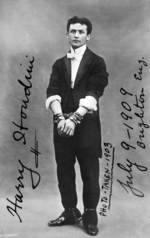
Houdini
As popular as Houdini was, it was no secret that Dr. Hardwicke had nothing but contempt for him. Greatly interested in Spiritualism following the death of his beloved mother, Houdini’s later years were spent furiously debunking fraudulent mediums. He traveled the globe uncovering wicked schemes, yet in the end there was no one who haunted him quite so much as the lovely Mina Crandon. Beautiful, intelligent, Mina would greet her visitors in a flimsy nightgown and silk stockings…attire which left very little to the imagination and bewitched many of the men. She made no financial gain from her gatherings. She was an enigma to many, especially Houdini, and quite possibly to Dr. Hardwicke, as well. She was pursued on every level; by men, women by Spiritualists, by fans and by enemies alike.
“You want to know what it feels like to be a witch? You know that’s what they would have called me in Boston 150 years ago. And they would have hauled me before the General Court and executed me for consorting with the devil but now they send committees of Professors from Harvard to study me. That represents progress, doesn’t it?”
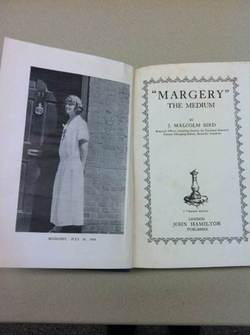
The story of “Margery” told by J. Malcolm Bird, one of the investigators
All attempts to debunk her had been countered successfully and she was often considered to be the most extraordinary medium in the world. She had her supporters and they were the most influential names in the field. Sir Arthur Conan Doyle, the well known author of the Sherlock Holmes mysteries, became deeply involved in Spiritualism following the death of his son in World War I, and was one of her most enthusiastic proponents. It was Conan Doyle who had recommended her to enter a $2,500 contest to prove psychic ability to the Scientific American and it was this action that introduced Mina to Houdini, one of the judges. Houdini found himself completely stumped, though he believed her to be the slickest ruse he had ever encountered. He stopped at nothing to prove she was a fraud though over and over again he was unable to prove it. In 1924, he created a special “Anti-Medium’s” cabinet so as to infringe upon all of her body’s movements so that there would be no possible way for her to commit any sort of false moves. Houdini, himself, held onto one of her hands while his assistant held her other. Walter exclaimed suddenly that Houdini had meddled with the bell-box and upon investigation there was indeed an item inserted so as to make it difficult to have the bell ring (an exercise that Walter would accomplish during a sitting). The next occasion involving Houdini and Mina involved Walter, again, communicating that Houdini had attempted once more to tamper with the investigation by placing a rule within the cabinet. Houdini denied it yet he would have been the only one with access to the area. Years later, Houdini’s assistant, Jimmy Collins, actually admitted to having been directed by his boss to secretly sabotage the investigation. “I chucked it in the box myself. The Boss told me to do it. ‘E wanted to fix her good.” Henry Hardwicke proclaimed his own pride in Mina’s continued success to a group of Niagara’s Spiritualists who met a few years later at the Unitarian Church for a lecture sponsored by the Survival League of America. It was to his great satisfaction that Walter had contemptuously “showed up Houdini…”
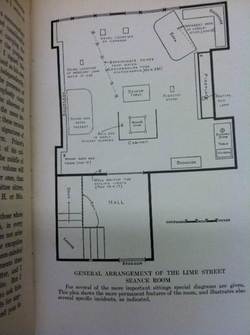
Diagram of the séance room at Lime Street
In the end, the investigators from Scientific American denied her the prize she had been seeking, mostly due to Houdini’s disagreements. However, Houdini could never actually present proof that she was fraudulent. Although, shortly after, he published an expose of the well known Boston medium, he “failed to satisfy those who were looking for final proof, which was, impossible to give because, logically, he couldn’t prove a negative—that spiritualism does not exist and that the dead do not survive…” On February 11, 1925, Scientific American issued their final report which explained that “…we have observed phenomena the method of production of which we cannot in every case claim to have discovered. But we have observed no phenomena of which we can assert that they could not have been produced by normal means…”

Houdini died on October 31, 1926, Halloween, supposedly from complications of appendicitis. Mina publicly revealed her sorrow at his passing and complimented the tenacity of his attacks upon her, although some ultimately feel she may have had something to do with his death. A few years later, Conan Doyle also died. Mina, who lost much of her credibility after it was found that the wax impressions were not of her brother, Walter’s, ghostly thumbprint, but of her dentist’s, continued to work at her mediumship, however from time to time found herself depressed and suicidal, at one occasion leaving a séance and hovering about her roof top where she threatened to jump.
Dr. Hardwicke continued with his work in the spiritual realm and took a job as an instructor at the newly conceived Galahad College in Asheville, North Carolina, in 1932, where he held most of the teaching duties under the infamous founder, William Dudley Pelley. The purpose of the college was “to overcome a general breakdown in religious conviction; to inspire psychical research; to help combat the menacing crime wave; and to instill the principle of Christ in the American industrial sphere…” A Fascist, anti-Semite and supporter of Hitler, Pelley used his college as a means of publishing his treatises blending spirituality with right wing extremism. Monte Hardwicke, Dr. Henry Hardwicke’s son, worked for Pelley, as well, as a printer. The college was short lived as it was in the midst of the Depression and Pelley was called before the House Un-American Activities Committee and imprisoned until the 1950’s. Things had not turned out as planned for the Hardwicke’s and on May 11, 1939, only 58 years of age, Dr. Henry Hardwicke was dead. Strangely, Mina Crandon died not too long after, on November 1, 1941, All Saints Day, the day that western theology commemorates those who have obtained the beatific vision of heaven.
In the end, they took all of their secrets to their graves.
Interestingly enough, Dr. Hardwicke ends his little book with a scene at Fort Niagara where he wonders about the end of life.
Why does not science, to which the way is now open,--science, that traces the life of the smallest insets through their various stages of existence, show man the answer to his most persistent question?
“After the grave---what?”
Last page of “Voices from Beyond” by Dr. Henry Hardwicke,
Niagara Falls, New York
Whatever the answer, so ends the story of Niagara’s, Dr. Henry Hardwicke. Perhaps.
